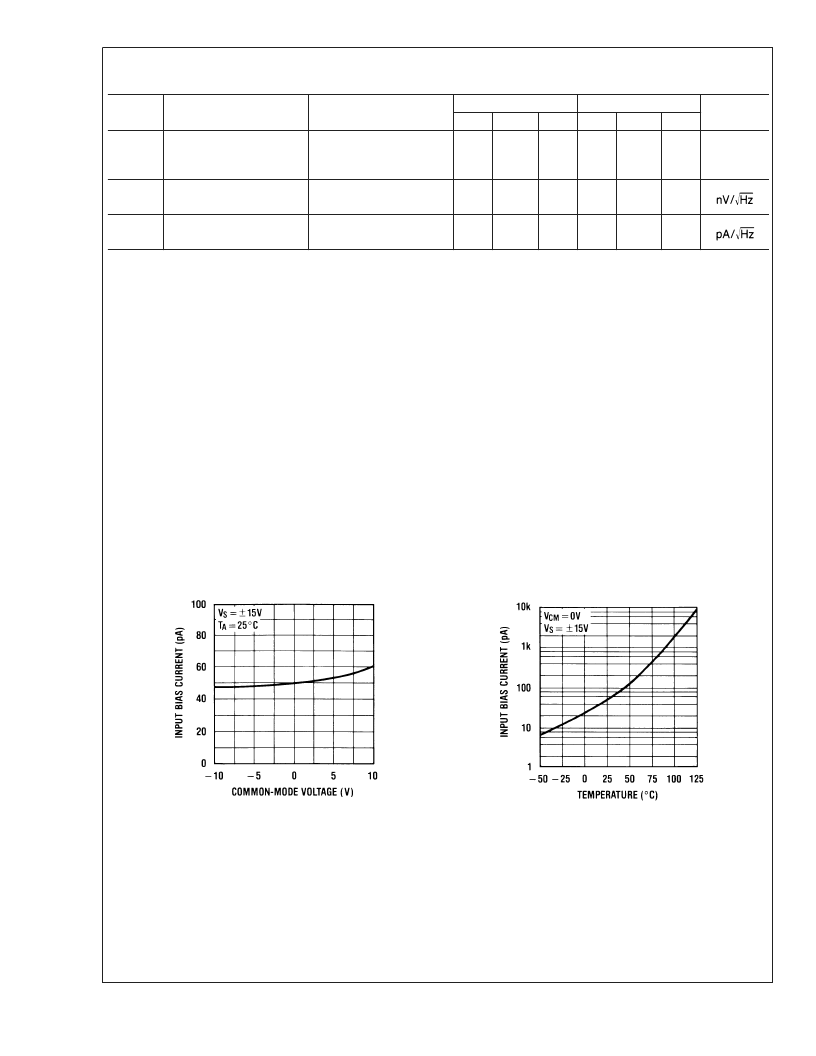- 您現(xiàn)在的位置:買賣IC網(wǎng) > PDF目錄361022 > LF412CH (NATIONAL SEMICONDUCTOR CORP) Low Offset, Low Drift Dual JFET Input Operational Amplifier PDF資料下載
參數(shù)資料
| 型號: | LF412CH |
| 廠商: | NATIONAL SEMICONDUCTOR CORP |
| 元件分類: | 運算放大器 |
| 英文描述: | Low Offset, Low Drift Dual JFET Input Operational Amplifier |
| 中文描述: | DUAL OP-AMP, 3000 uV OFFSET-MAX, 4 MHz BAND WIDTH, MBCY8 |
| 封裝: | METAL CAN-8 |
| 文件頁數(shù): | 4/13頁 |
| 文件大小: | 565K |
| 代理商: | LF412CH |

AC Electrical Characteristics
(Continued)
(Note 7)
Symbol
Parameter
Conditions
LF412A
Typ
≤
0.02
LF412
Typ
≤
0.02
Units
Min
Max
Min
Max
THD
Total Harmonic Dist
A
V
=+10, R
L
=10k,
V
O
=20 Vp-p,
BW=20 Hz-20 kHz
T
A
=25C, R
S
=100
,
f=1 kHz
T
A
=25C, f=1 kHz
%
e
n
Equivalent Input Noise
Voltage
Equivalent Input Noise
Current
25
25
i
n
0.01
0.01
Note 3:
Unless otherwise specified the absolute maximum negative input voltage is equal to the negative power supply voltage.
Note 4:
Any of the amplifier outputs can be shorted to ground indefintely, however, more than one should not be simultaneously shorted as the maximum junction
temperature will be exceeded.
Note 5:
For operating at elevated temperature, these devices must be derated based on a thermal resistance of
θ
jA
.
Note 6:
These devices are available in both the commercial temperature range 0C
≤
T
A
≤
70C and the military temperature range 55C
≤
T
A
≤
125C. The
temperature range is designated by the position just before the package type in the device number. A “C” indicates the commercial temperature range and an “M”
indicates the military temperature range. The military temperature range is available in “H” package only. In all cases the maximum operating temperature is limited
by internal junction temperature T
j
max.
Note 7:
Unless otherwise specified, the specifications apply over the full temperature range and for V
S
=
±
20V for the LF412A and for V
S
=
±
15V for the LF412. V
OS
,
I
B
, and I
OS
are measured at V
CM
=0.
Note 8:
The LF412A is 100% tested to this specification. The LF412 is sample tested on a per amplifier basis to insure at least 85% of the amplifiers meet this
specification.
Note 9:
The input bias currents are junction leakage currents which approximately double for every 10C increase in the junction temperature, T
. Due to limited
production test time, the input bias currents measured are correlated to junction temperature. In normal operation the junction temperature rises above the ambient
temperature as a result of internal power dissipation, P
. T
j
=T
A
+
θ
jA
P
D
where
θ
jA
is the thermal resistance from junction to ambient. Use of a heat sink is
recommended if input bias current is to be kept to a minimum.
Note 10:
Supply voltage rejection ratio is measured for both supply magnitudes increasing or decreasing simultaneously in accordance with common practice. V
S
=
±
6V to
±
15V.
Note 11:
Refer to RETS412X for LF412MH and LF412MJ military specifications.
Note 12:
Max. Power Dissipation is defined by the package characteristics. Operating the part near the Max. Power Dissipation may cause the part to operate
outside guaranteed limits.
Note 13:
Human body model, 1.5 k
in series with 100 pF.
Typical Performance Characteristics
Input Bias Current
Input Bias Current
00565610
00565611
L
www.national.com
4
相關(guān)PDF資料 |
PDF描述 |
|---|---|
| LF412CN | Low Offset, Low Drift Dual JFET Input Operational Amplifier |
| LF412MH | Low Offset, Low Drift Dual JFET Input Operational Amplifier |
| LF412CN8 | Dual Precision JFET Input Operational Amplifiers |
| LF412MH | Dual Precision JFET Input Operational Amplifiers |
| LF412MJ8 | Dual Precision JFET Input Operational Amplifiers |
相關(guān)代理商/技術(shù)參數(shù) |
參數(shù)描述 |
|---|---|
| LF412CH/A+ | 制造商:未知廠家 制造商全稱:未知廠家 功能描述:Voltage-Feedback Operational Amplifier |
| LF412CH/NOPB | 制造商:Texas Instruments 功能描述:OPERATIONAL AMPLIFIER EOL011209 |
| LF412CJ8 | 制造商:LINER 制造商全稱:Linear Technology 功能描述:Dual Precision JFET Input Operational Amplifiers |
| LF412CJG | 制造商:未知廠家 制造商全稱:未知廠家 功能描述:Voltage-Feedback Operational Amplifier |
| LF412CN | 功能描述:運算放大器 - 運放 RoHS:否 制造商:STMicroelectronics 通道數(shù)量:4 共模抑制比(最小值):63 dB 輸入補償電壓:1 mV 輸入偏流(最大值):10 pA 工作電源電壓:2.7 V to 5.5 V 安裝風格:SMD/SMT 封裝 / 箱體:QFN-16 轉(zhuǎn)換速度:0.89 V/us 關(guān)閉:No 輸出電流:55 mA 最大工作溫度:+ 125 C 封裝:Reel |
發(fā)布緊急采購,3分鐘左右您將得到回復。